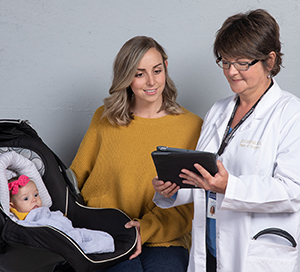Diabetes: After Delivery (Postpartum)
Pregnancy changes your body in many ways. If you have diabetes, pregnancy can also change how your body uses insulin. You’ll need to adapt your diabetes management plan before, during, and after giving birth. Your healthcare provider will work with you to help you keep diabetes under control during this exciting time.

After delivery
After you give birth, your body becomes much more sensitive to insulin. This increases your risk of having low blood sugar (hypoglycemia). So it’s important to keep track of your blood sugar levels closely.
Your need for insulin drops fast in the first few hours and days after birth. In fact, you may need little or no insulin at all. A few days after giving birth, you may only need half the insulin dose you were taking before delivery. For these reasons, it’s important to keep fast-acting sources of glucose with you at all times in case your blood sugar drops. Also keep your blood sugar monitor close by. This is especially important when caring for a newborn. Fast-acting sources of glucose include:
-
Glucose gel or tablets
-
Hard candy
-
Juice
-
Non-diet soda
-
Sugar, jelly, or honey
Breastfeeding
Breastmilk is the best food for your new baby. But be aware that breastfeeding also makes you more sensitive to insulin. It may also help you lose weight postpartum. This can also affect how your body uses insulin. Eat a small snack before you start breastfeeding. This will help prevent low blood sugar. Also keep your blood sugar monitor and fast-acting glucose sources close by.
Going home with baby
Caring for a newborn can be a challenge. Add managing your diabetes to the picture and you may feel overwhelmed. Your body is now changing back to its nonpregnant state. This means hormone and emotional ups and downs. You are also likely not getting enough sleep. It can be tough to stay on top of your diabetes care. Keep watch for signs of postpartum depression. And follow these tips:
-
Get enough sleep
-
Have the support of family and friends
-
Eat well
-
Ask for help and accept help from others
-
Check your blood sugar often
Healthcare after pregnancy
You were likely followed very closely by your healthcare provider during your final weeks of pregnancy. After you go home with your baby, it may be difficult to return to your routine prepregnancy diabetes care. But don’t hesitate to check in with your healthcare provider if you have challenges with your diabetes care.
Part of your prenatal care may have included eye exams to check for retinopathy. Pregnancy can increase your risk for this disorder. The American Diabetes Association recommends you continue these checks for 1 year after birth.
Many women with diabetes deliver their baby by cesarean. This may be because the mother has a diabetes-related complication, such as high blood pressure, which makes scheduled cesareans necessary. In addition, the baby of a mother with diabetes can be larger than other babies. Diabetes raises your risk for infections. So, it’s very important to watch for signs that your cesarean incision is infected, as listed below. These include redness or draining from your incision.
Planning a future pregnancy
Planning pregnancy is important in people with diabetes to achieve the blood sugar goals to prevent birth defects and the risk of other complications. A pre-pregnancy evaluation is advised for people who have diabetes. Talk to your healthcare provider before you plan your next pregnancy. And remember that it’s possible to get pregnant again soon after you give birth. Talk with your healthcare provider about the best method of birth control for you and your partner.
When to call your healthcare provider
Call your healthcare provider if you:
Have symptoms of low blood sugar, such as:
-
Shakiness
-
Sweating
-
Confusion
-
Feeling sleepy
-
Thirsty
Have other symptoms, such as:
-
Burning or pain in your breasts
-
Red streaks or hard lumpy areas in your breasts
-
Problems with breastfeeding
-
A fever of 100.4°F (38°C) or higher, or as directed by your healthcare provider
-
Feeling very tired or have body aches, as if you have the flu
-
Belly pain that doesn’t go away with medicine
-
Can’t urinate or have a bowel movement after 1 week
-
Vaginal discharge that has a bad odor
-
Vaginal bleeding that soaks more than 1 pad an hour
-
If you had a cesarean section, call for concerns about your incision site. These include pain, drainage, or bleeding from your incision.
-
Pain or urgency with urination
-
Swollen, red, painful area in the leg